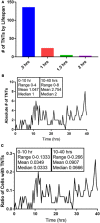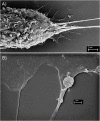Cellular and Molecular Networking Within the Ecosystem of Cancer Cell Communication via Tunneling Nanotubes
- PMID: 30333973
- PMCID: PMC6176212
- DOI: 10.3389/fcell.2018.00095
Cellular and Molecular Networking Within the Ecosystem of Cancer Cell Communication via Tunneling Nanotubes
Abstract
Intercellular communication is vital to the ecosystem of cancer cell organization and invasion. Identification of key cellular cargo and their varied modes of transport are important considerations in understanding the basic mechanisms of cancer cell growth. Gap junctions, exosomes, and apoptotic bodies play key roles as physical modalities in mediating intercellular transport. Tunneling nanotubes (TNTs)-narrow actin-based cytoplasmic extensions-are unique structures that facilitate direct, long distance cell-to-cell transport of cargo, including microRNAs, mitochondria, and a variety of other sub cellular components. The transport of cargo via TNTs occurs between malignant and stromal cells and can lead to changes in gene regulation that propagate the cancer phenotype. More notably, the transfer of these varied molecules almost invariably plays a critical role in the communication between cancer cells themselves in an effort to resist death by chemotherapy and promote the growth and metastases of the primary oncogenic cell. The more traditional definition of "Systems Biology" is the computational and mathematical modeling of complex biological systems. The concept, however, is now used more widely in biology for a variety of contexts, including interdisciplinary fields of study that focus on complex interactions within biological systems and how these interactions give rise to the function and behavior of such systems. In fact, it is imperative to understand and reconstruct components in their native context rather than examining them separately. The long-term objective of evaluating cancer ecosystems in their proper context is to better diagnose, classify, and more accurately predict the outcome of cancer treatment. Communication is essential for the advancement and evolution of the tumor ecosystem. This interplay results in cancer progression. As key mediators of intercellular communication within the tumor ecosystem, TNTs are the central topic of this article.
Keywords: angiogenesis; cancer ecosystems; cancer pathophysiology; intercellular communication; intercellular transfer; tumor microenvironment; tumor microtubes; tunneling nanotubes.
Figures









Similar articles
-
A Ticket to Ride: The Implications of Direct Intercellular Communication via Tunneling Nanotubes in Peritoneal and Other Invasive Malignancies.Front Oncol. 2020 Nov 26;10:559548. doi: 10.3389/fonc.2020.559548. eCollection 2020. Front Oncol. 2020. PMID: 33324545 Free PMC article. Review.
-
Do tunneling nanotubes drive chemoresistance in solid tumors and other malignancies?Biochem Soc Trans. 2024 Aug 28;52(4):1757-1764. doi: 10.1042/BST20231364. Biochem Soc Trans. 2024. PMID: 39034648 Free PMC article. Review.
-
Tunneling Nanotubes and Tumor Microtubes in Cancer.Cancers (Basel). 2020 Apr 1;12(4):857. doi: 10.3390/cancers12040857. Cancers (Basel). 2020. PMID: 32244839 Free PMC article. Review.
-
Tunneling Nanotubes: A new paradigm for studying intercellular communication and therapeutics in cancer.Commun Integr Biol. 2012 Jul 1;5(4):399-403. doi: 10.4161/cib.20569. Commun Integr Biol. 2012. PMID: 23060969 Free PMC article.
-
Intercellular communication in malignant pleural mesothelioma: properties of tunneling nanotubes.Front Physiol. 2014 Oct 31;5:400. doi: 10.3389/fphys.2014.00400. eCollection 2014. Front Physiol. 2014. PMID: 25400582 Free PMC article.
Cited by
-
MICAL2PV suppresses the formation of tunneling nanotubes and modulates mitochondrial trafficking.EMBO Rep. 2021 Jul 5;22(7):e52006. doi: 10.15252/embr.202052006. Epub 2021 Jun 6. EMBO Rep. 2021. PMID: 34096155 Free PMC article.
-
Targeting mitochondria: a novel approach for treating platinum-resistant ovarian cancer.J Transl Med. 2024 Oct 25;22(1):968. doi: 10.1186/s12967-024-05770-y. J Transl Med. 2024. PMID: 39456101 Free PMC article. Review.
-
TNTdetect.AI: A Deep Learning Model for Automated Detection and Counting of Tunneling Nanotubes in Microscopy Images.Cancers (Basel). 2022 Oct 10;14(19):4958. doi: 10.3390/cancers14194958. Cancers (Basel). 2022. PMID: 36230881 Free PMC article.
-
Tumor-Stroma Proportion to Predict Chemoresistance in Patients With Ovarian Cancer.JAMA Netw Open. 2024 Feb 5;7(2):e240407. doi: 10.1001/jamanetworkopen.2024.0407. JAMA Netw Open. 2024. PMID: 38411963 Free PMC article.
-
Protective effect of the tunneling nanotube-TNFAIP2/M-sec system on podocyte autophagy in diabetic nephropathy.Autophagy. 2023 Feb;19(2):505-524. doi: 10.1080/15548627.2022.2080382. Epub 2022 Jun 6. Autophagy. 2023. PMID: 35659195 Free PMC article.
References
Grants and funding
LinkOut - more resources
Full Text Sources
Research Materials
Miscellaneous

